Best Dog for Allergies — Say Goodbye to the Sniffles

From Sneezes to Smiles: The Best Dog for Allergies!
With 10 to 20 percent of the world’s population affected by dog allergies, for many people, the idea of owning a pooch seems like an unattainable dream. Some would even argue the best dog for allergies is no dog!
Although no four-legged friend can be 100 percent hypoallergenic, certain breeds can be less likely to trigger a reaction and make great companions for those with allergies to canines. Join us as we look at some of the best dog breeds for allergies.
What Causes Dog Allergies?
Contrary to popular belief, it’s not dogs’ hair we’re allergic to but a protein in their dander (dead skin), saliva, and urine. Different breeds produce different types of this protein, so it’s possible to be more sensitive to certain breeds than others.
Eventually, the allergen — in dried saliva/urine or dander — finds its way into the animal’s fur. When the dog sheds, it travels with the dead hair — leaving it around your home for you to breathe in and triggering a reaction.
10 of the Best Dogs for People With Allergies
As mentioned, no dog is 100 percent allergy-friendly. However, the following breeds are considered by breeders and kennel clubs to be among the best dogs for allergies and asthma sufferers.
1. American Hairless Terrier

The only hairless breed indigenous to the US, the American Hairless Terrier is described by the AKC as “hypoallergenic as a dog can get.” The only hair you’ll find on this toy-sized canine is their eyebrows and whiskers. Hence, little place for dander to hide with the slightest of shedding, if any at all.
Despite their name, the AHT can come with a short, shiny coat too. The grooming needs of both varieties are minimal — with a quick once-a-week brush of the short coat needed or ensuring the hairless pup is protected from sunburn. Although both produce some dander, the hairless pup is more of a fit if you suffer from allergies.
The American Hairless Terrier is loyal, smart, and fiercely protective yet also playful — a great companion for the whole family, including children. Also, ideal for city dwellers, this hairless Terrier has only moderate exercise demands — regular short walks and some indoor playtime will keep them content.
2. Bichon Frise
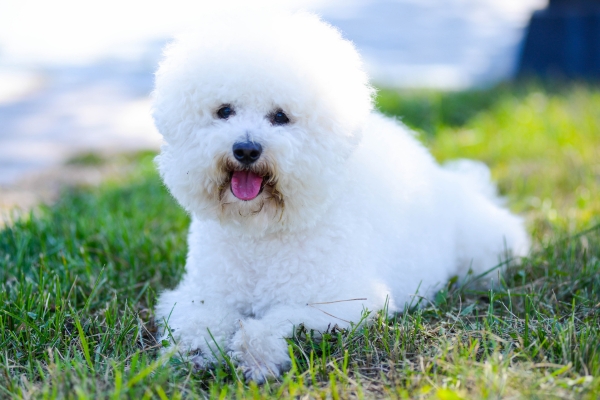
In contrast to the American Hairless, here’s one of the smallest, cute, fluffy white dogs. Even though they look like a powder puff on legs, the Bichon Frise sheds very little and is one of the best dogs for people with allergies.
The hair of a Bichon continually grows, but it gets caught up in their undercoat. Hence, it has to be brushed out to prevent matting. Daily brushing, monthly bathing with a quality dog shampoo, and frequent haircuts are a must with this high-maintenance, hypoallergenic breed.
Personality-wise, Bichons are happy little pooches who always seem to be smiling. They’re super sociable, they even mix well with other dogs, and thanks to their diminutive size, are great playmates for children. The Bichon is eager to please, confident, and ideal for those seeking a non-shedding lap dog.
3. Maltese
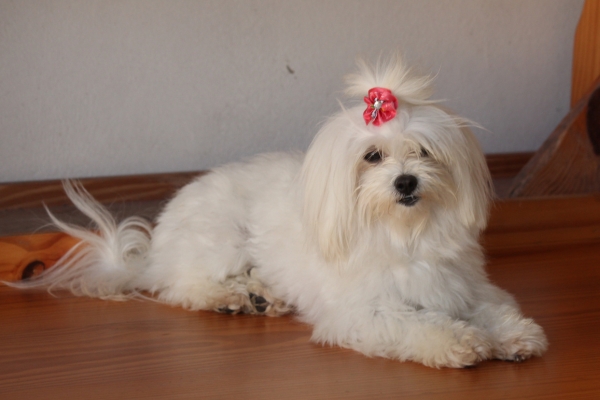
The Maltese is another cute, little white dog, but tends to have a bit more spunk than the Bichon. You should brush these bow-wows that don’t shed every day to prevent mats from forming in their long, silky coats.
A very adaptable breed, the Maltese is surprisingly fearless for such a small pooch and makes a great alert dog. They’re also very agile and athletic, making them great fun to take on adventures or to a local agility course.
Although they’re very trainable, especially with a rewards-based training regime, the Maltese can be stubborn and wilful. And, don’t let their small innocent appearance fool you — this pint-sized pooch can be feisty and bold, and may often face up to larger dogs too.
4. Peruvian Inca Orchid
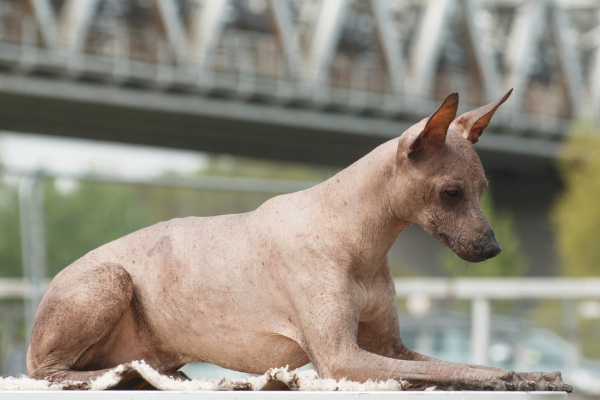
The Peruvian Inca Orchid is another breed that’s considered hypoallergenic with either a short-haired coat or no hair (hairless), meaning they shed less floating dander. In the hairless variety, the skin can be any color, while the coated variety is accepted in all colors, including black, brown, gray, pink, tan, and white.
Although they’re alert and lively sighthounds, care should be taken when the hairless Peruvian Inca is outdoors — don’t forget to slap on plenty of sunscreen on sunny days. Aside from regular skincare/grooming, an occasional bath should keep your PIO clean and looking their best.
An affectionate companion dog, the Peruvian has the same elegant muscular contours as their Whippet or Greyhound relatives. They also come in three sizes, small, medium, and large — so pick your preference. Loyal and protective of their family, but like all hounds, caution should be taken with smaller pets who are often viewed as prey.
5. Poodle
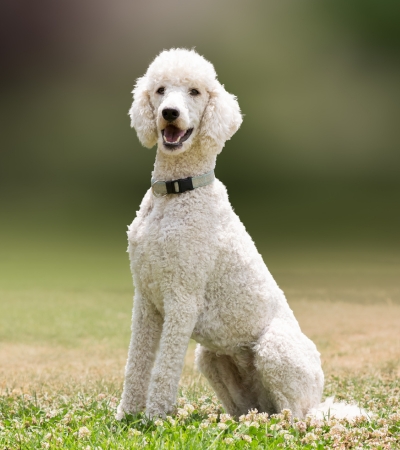
The Poodle is the gold standard of all allergy friendly dogs. Despite their distinctive ‘big-hair’ appearance, this breed is super low-shedding. Their curly-haired coat, however, can be high maintenance — with many pet parents opting to keep them clipped short for easier upkeep.
Available in three sizes, from toy to miniature up to standard, the Poodle’s shed hairs get caught in their coat, which will need daily brushing to remove them.
All three sizes are highly active, sporty, smart, and easy to train. Eager to please their owners, they make great family pets and are especially known to get on well with children, who they will keep amused for hours with their playful nature. Best of all, the Poodle is one of the longest-living dog breeds — so you can look forward to years of allergy-free companionship for the whole family.
6. Afghan Hound

It may seem strange to look at a long-haired breed like the Afghan Hound when talking about the best dog breeds for allergies. However, a single-coated breed, the Afghan’s stunning, silky hair is akin to human hair — it keeps growing and doesn't shed that much. But, it will demand a lot of your attention to keep it in top condition.
Intelligent and independent, Afghans are a charming Ancient breed with unwavering loyalty to their owners. Their size and immense speed mean they need a large fenced-in yard (they’re agile jumpers) and plenty of daily exercise.
While they’re reserved at times, the Afghan can often display a streak of silliness too — depending on their mood. They can also be patient and gentle with children, if brought up with them. However, Afghans aren’t one for rowdy play. And, if this breed sees a smaller animal, it will give chase, so bear this in mind if you have other pets.
7. Soft-Coated Wheaten Terrier

The ever-happy and loyal Wheaten certainly lives up to the soft-coated part of their name — with a medium-length wavy coat that feels like velvet. Their single coat sheds minimally, but will need regular grooming to keep it free of mats — keep that comb and brush handy at all times!
Originally from Ireland, this pup definitely enjoys the craic and needs plenty of exercise. They adapt well to city, country, or suburban living and make great companion dogs for families with a more active lifestyle and who are willing to devote significant time to — firm but fair — training.
Although the Wheaten gets on well with most children, remember they’re Terriers and can be headstrong. Topping out at 19 inches tall and 40 pounds in weight, Wheatens are sturdy canines with a hard-muscled frame. Think of the Soft Coated Wheaten Terrier as an iron fist in a velvet glove.
8. Bedlington Terrier

Looking more like a baby lamb, the Bedlington Terrier has long fuzzy ears and a soft curly coat that’s low shedding and low dander, making them one of the best dogs for allergies and asthma sufferers.
However, the coat of this breed isn’t necessarily low maintenance. It grows very quickly and needs to be clipped at least every two months with both clippers and scissors. They also need to be brushed or combed once or twice a week.
This English-originating Terrier has often been referred to as a Terrier in sheep's clothing. The Bedlington has a light, springy step, which when roused, can make them run like the wind, they’re alert watchdogs and versatile athletes but also make irresistibly cuddly couch companions. The Bedlington loves being the center of attention and is very protective of their loved ones.
9. Irish Water Spaniel

Another breed originating from the Emerald Isle is the Irish Water Spaniel — the clown of the Spaniel family. With their soft, tight brown curls, this Poodle look-alike breed has a waterproof double coat, ideal for those swimming sessions, as their name suggests.
The coat of the Irish is considered low dander, so perfect for those who suffer from mild allergies. However, you will need to brush weekly at the very least. A trim every couple of months will also prevent them from looking scruffy.
Eager to please and easy to train, the Irish Water Spaniel is an active and high-energy companion who needs lots of exercise. Homes with access to nearby water make an ideal environment for this champion swimmer of the canine world. And, the Irish will make an ideal playmate for your children.
10. Puli
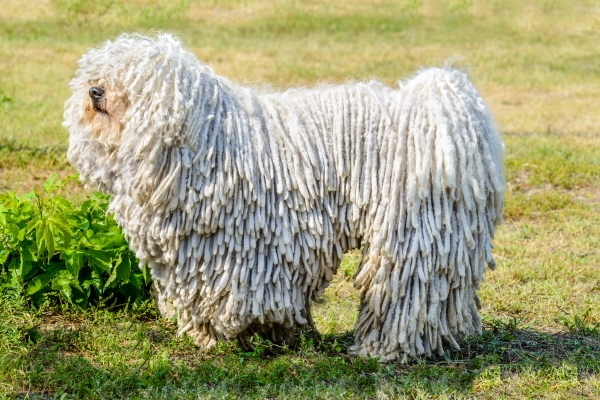
Looking like a walking mop, Pulik are allergy friendly dogs with a distinctive coat.
The hypoallergenic dreadlock-like cords are wooly, dense, and weatherproof. While they don’t shed much, whether the coat is corded or brushed out, it will demand plenty of attention.
The fur of the Puli can get dirty quickly too, as their thick coat often traps debris. Teasing apart the cords of a Puli with your fingers should remove any detritus along with soft clumps where the hair has matted. And, when you eventually bathe your Puli, be prepared to wait all day for their coat to dry completely.
Underneath that mop, is an active, intelligent, and self-confident dog who is fiercely dedicated to their family and friends. Known for their sense of humor, Pulik make great companions for kids and adults alike. Just be warned, that herding instinct can see the Puli nipping at the heels of their owners if not properly trained.
Final Thoughts
Just because you suffer from dog allergies doesn’t mean you can never own a dog or be doomed to a life of antihistamines. As we’ve seen, many breeds are considered hypoallergenic and reduce the risk of exposure to allergens around your home.
However, it’s not just about how much they shed, you should also consider the other traits of a breed — activity and trainability levels, grooming demands, temperament, etc., — and whether they pair well with your lifestyle.
In short, be it long-haired, short-haired, or even no-haired, small, medium, or large — there is no one-size-fits-all best dog for allergies. But with such a varied group of hypoallergenic breeds, you’re sure to find your favorite four-legged friend.
Best Dog for Allergies FAQs
What Are the Symptoms of a Dog Allergy?
If allergic, after exposure to a dog, you could experience any of the following:
Swelling and/or itchiness around the eyes or the nose.
Sneezing.
Runny nose or nasal congestion.
Red areas of skin (if licked by your pup).
Breathing problems — e.g., a constant cough, wheezing, or feeling short of breath.
Rash — on areas such as your neck, face, or chest.
Can Exposing a Newborn to a Dog Increase the Risk of Allergies?
No! Fortunately, the opposite appears to be true for dog owners. Research suggests early exposure may protect a child from developing allergies or asthma in the future.
Can OTC Medications Help with Dog Allergies?
There are over-the-counter medications that can help alleviate your symptoms, including:
Antihistamines.
Nasal corticosteroids.
Decongestants.
Can Lifestyle Changes Help with Dog Allergies?
Yes. Here are a few ways you can reduce allergens, or the risk of exposure to them:
Setting up dog-free zones — e.g., a bedroom where the dog isn’t allowed.
Removing any carpeting, upholstery, or other items that may attract dander.
Using a HEPA filter (high-efficiency particulate air) air purifier to reduce airborne allergens.
Vacuum regularly.
Change your clothes and wash your hands after petting your dog.
What Are the Worst Dogs for Allergies?
If you struggle with dog allergies, here are a few breeds to steer clear of:
Basset Hound.
Husky.
Boston Terrier.
Chow Chow.
Bulldog.
German Shepherd.
Labrador Retriever.
Pekingese.
Saint Bernard.
